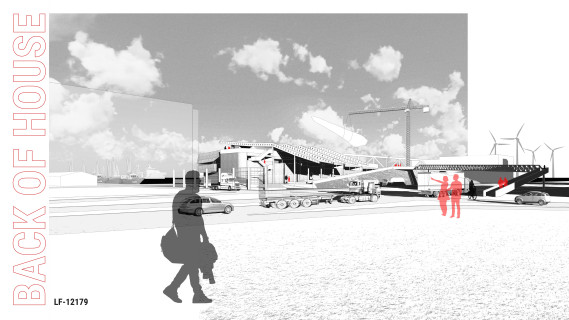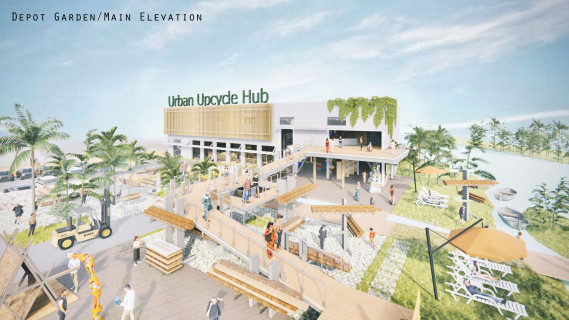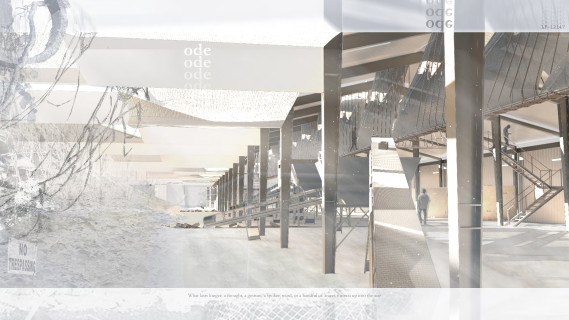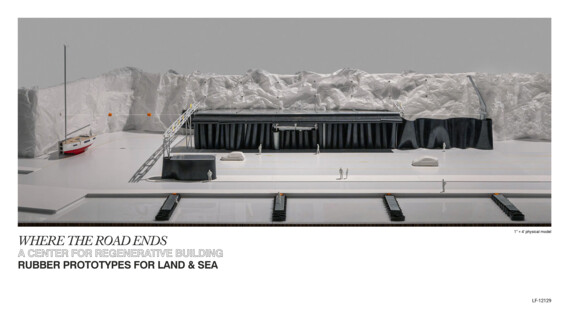- wa-ID
- wa-2036863
- Tag der Veröffentlichung
- 19.09.2023
- Aktualisiert am
- 24.07.2024
- Verfahrensart
- Offener Wettbewerb
- Zulassungsbereich
-
Andere
- Auslober
- Lyceum Fellowship
- Abgabetermin
- 23.05.2024
- Bekanntgabe
- 17.07.2024
Verfahrensart
Offener Wettbewerb
Wettbewerbsaufgabe
Der Lyceum Wettbewerb 2024 erforscht die potenziell regenerative Symbiose zwischen dem unvermeidlichen Wachstum der menschlichen Besiedlung - unserer Gebäude und Infrastrukturen, unserer Städte und Gemeinden - und der wesentlichen Gesundheit unseres terrestrischen Ökosystems. Das Programm sieht einen neuen, hybriden Gebäudetyp vor, einen "Makerspace", der als wesentlicher Bestandteil eines regionalen wirtschaftlichen und ökologischen Stoffwechsels fungiert. Das Gebäude selbst wird als Modell für regenerative Planung und Konstruktion dienen.
Als lokale Ressource mit globaler Perspektive will das Zentrum für Regeneratives Bauen zeigen, dass wir als Architekten und Bauherren in der Lage sind, den gegenwärtigen globalen Austausch von Material und Energie, der mit unseren Aktivitäten als Bauherren verbunden ist, einzudämmen und zu regionalisieren. Diese erweiterte Reihe von Entwurfszielen dient dazu, die traditionelleren Anliegen des freudvollen, schönen und sinnvollen Bauens für eine gesellige gebaute Umwelt und eine gerechte Gesellschaft zu verstärken.
Drei primäre programmatische Elemente bilden das Zentrum für Regeneratives Bauen:
- eine kommunale Baumaterial-"Bank" mit Außen- und Innenräumen für die Sammlung, Aufbereitung, Lagerung, Ausstellung, den Austausch und die Wiederverwendung von biobasierten Materialien und Reststoffen.
- eine Einrichtung für Bauexperimente, Berufsausbildung und Vorführungen zur Förderung neuer mikroökonomischer Unternehmen, zur Schaffung von Beschäftigungsmöglichkeiten für Arbeitskräfte und zur Befähigung von Bauherren, ihre eigenen Häuser und Arbeitsräume zu bauen, zu warten und zu reparieren.
- ein Wohnheim (Kurzzeitwohnungen und Gemeinschaftseinrichtungen) für Gastpraktikanten.
Competition assignment
The 2024 Lyceum Competition explores the potentially regenerative symbiosis between the inevitable growth of human settlement—our buildings and infrastructure, our towns and cities—and the essential health of our terrestrial ecosystem. The program calls for a new, hybrid building type, a „maker space“ that functions as an essential component of a regional economic and ecological metabolism. The building itself will serve as a model of regenerative design and construction.
As a local resource with a global outlook, the Center for Regenerative Building seeks to demonstrate our agency as architects and builders in reining in and regionalizing our current global exchange of material and energy associated with our activities as builders. This expanded set of design objectives serves to reinforce the more traditional concerns of building joyfully, beautifully, and meaningfully for a convivial built environment and equitable society.
Three primary programmatic elements comprise the Center for Regenerative Building:
- a community building material “bank” with exterior and interior spaces for bio-based and salvage material collection, preparation, storage, exhibition, exchange, and reuse.
- a facility for building experimentation, vocational training, and demonstration to encourage new micro-economic business enterprise, create workforce employment opportunity, and empower citizen builders to construct, maintain, and repair their own homes and workspaces.
- a hostel (short-stay housing and shared facilities) for visiting vocational trainees.
Jury
Elizabeth Gray, Principal, GOA
Alan Organschi, Principal, GOA
Rosalie Genevro, Adjunct Associate Professor, Columbia University & The Cooper Union, Former Executive Director, The Architectural League of New York (1985-2023)
Marlon Blackwell, FAIA, Principal, Marlon Blackwell Architects, Lyceum Fellowship 2007 Program Author & Jury Chair
Rashida Ng, Presidential Associate Professor of Architecture, Chair, Undergraduate Architecture, University of Pennsylvania Stuart Weitzman School of Design
Michael Pardek, Vice President, Director of Design, SMMA, Director, Lyceum Fellowship
Weitere Informationen zu allen Gewinner*innen finden Sie unter /
More information about all winners can be found at:
lyceum-fellowship.org/2024
Offener Wettbewerb
Wettbewerbsaufgabe
Der Lyceum Wettbewerb 2024 erforscht die potenziell regenerative Symbiose zwischen dem unvermeidlichen Wachstum der menschlichen Besiedlung - unserer Gebäude und Infrastrukturen, unserer Städte und Gemeinden - und der wesentlichen Gesundheit unseres terrestrischen Ökosystems. Das Programm sieht einen neuen, hybriden Gebäudetyp vor, einen "Makerspace", der als wesentlicher Bestandteil eines regionalen wirtschaftlichen und ökologischen Stoffwechsels fungiert. Das Gebäude selbst wird als Modell für regenerative Planung und Konstruktion dienen.
Als lokale Ressource mit globaler Perspektive will das Zentrum für Regeneratives Bauen zeigen, dass wir als Architekten und Bauherren in der Lage sind, den gegenwärtigen globalen Austausch von Material und Energie, der mit unseren Aktivitäten als Bauherren verbunden ist, einzudämmen und zu regionalisieren. Diese erweiterte Reihe von Entwurfszielen dient dazu, die traditionelleren Anliegen des freudvollen, schönen und sinnvollen Bauens für eine gesellige gebaute Umwelt und eine gerechte Gesellschaft zu verstärken.
Drei primäre programmatische Elemente bilden das Zentrum für Regeneratives Bauen:
- eine kommunale Baumaterial-"Bank" mit Außen- und Innenräumen für die Sammlung, Aufbereitung, Lagerung, Ausstellung, den Austausch und die Wiederverwendung von biobasierten Materialien und Reststoffen.
- eine Einrichtung für Bauexperimente, Berufsausbildung und Vorführungen zur Förderung neuer mikroökonomischer Unternehmen, zur Schaffung von Beschäftigungsmöglichkeiten für Arbeitskräfte und zur Befähigung von Bauherren, ihre eigenen Häuser und Arbeitsräume zu bauen, zu warten und zu reparieren.
- ein Wohnheim (Kurzzeitwohnungen und Gemeinschaftseinrichtungen) für Gastpraktikanten.
Competition assignment
The 2024 Lyceum Competition explores the potentially regenerative symbiosis between the inevitable growth of human settlement—our buildings and infrastructure, our towns and cities—and the essential health of our terrestrial ecosystem. The program calls for a new, hybrid building type, a „maker space“ that functions as an essential component of a regional economic and ecological metabolism. The building itself will serve as a model of regenerative design and construction.
As a local resource with a global outlook, the Center for Regenerative Building seeks to demonstrate our agency as architects and builders in reining in and regionalizing our current global exchange of material and energy associated with our activities as builders. This expanded set of design objectives serves to reinforce the more traditional concerns of building joyfully, beautifully, and meaningfully for a convivial built environment and equitable society.
Three primary programmatic elements comprise the Center for Regenerative Building:
- a community building material “bank” with exterior and interior spaces for bio-based and salvage material collection, preparation, storage, exhibition, exchange, and reuse.
- a facility for building experimentation, vocational training, and demonstration to encourage new micro-economic business enterprise, create workforce employment opportunity, and empower citizen builders to construct, maintain, and repair their own homes and workspaces.
- a hostel (short-stay housing and shared facilities) for visiting vocational trainees.
Jury
Elizabeth Gray, Principal, GOA
Alan Organschi, Principal, GOA
Rosalie Genevro, Adjunct Associate Professor, Columbia University & The Cooper Union, Former Executive Director, The Architectural League of New York (1985-2023)
Marlon Blackwell, FAIA, Principal, Marlon Blackwell Architects, Lyceum Fellowship 2007 Program Author & Jury Chair
Rashida Ng, Presidential Associate Professor of Architecture, Chair, Undergraduate Architecture, University of Pennsylvania Stuart Weitzman School of Design
Michael Pardek, Vice President, Director of Design, SMMA, Director, Lyceum Fellowship
Weitere Informationen zu allen Gewinner*innen finden Sie unter /
More information about all winners can be found at:
lyceum-fellowship.org/2024
2024 Lyceum Competition | Re-forming The Anthropocene: A Center For Regenerative Building
Organizers
Lyceum Fellowship
Overview
The 2024 Lyceum Competition explores the potentially regenerative symbiosis between the inevitable growth of human settlement—our buildings and infrastructure, our towns and cities—and the essential health of our terrestrial ecosystem. The program calls for a new, hybrid building type, a „maker space“ that functions as an essential component of a regional economic and ecological metabolism. The building itself will serve as a model of regenerative design and construction.
As a local resource with a global outlook, the Center for Regenerative Building seeks to demonstrate our agency as architects and builders in reining in and regionalizing our current global exchange of material and energy associated with our activities as builders. This expanded set of design objectives serves to reinforce the more traditional concerns of building joyfully, beautifully, and meaningfully for a convivial built environment and equitable society.
Three primary programmatic elements comprise the Center for Regenerative Building:
- a community building material “bank” with exterior and interior spaces for bio-based and salvage material collection, preparation, storage, exhibition, exchange, and reuse.
- a facility for building experimentation, vocational training, and demonstration to encourage new micro-economic business enterprise, create workforce employment opportunity, and empower citizen builders to construct, maintain, and repair their own homes and workspaces.
- a hostel (short-stay housing and shared facilities) for visiting vocational trainees.
Schedule
Entry deadline: May 23, 2024
Jury
Elizabeth Gray, Principal, Gray Organschi Architecture
Alan Organschi, Principal, Gray Organschi Architecture
Michael Pardek, Vice President, Director of Design, SMMA, Director Lyceum Fellowship
More information and documents










































